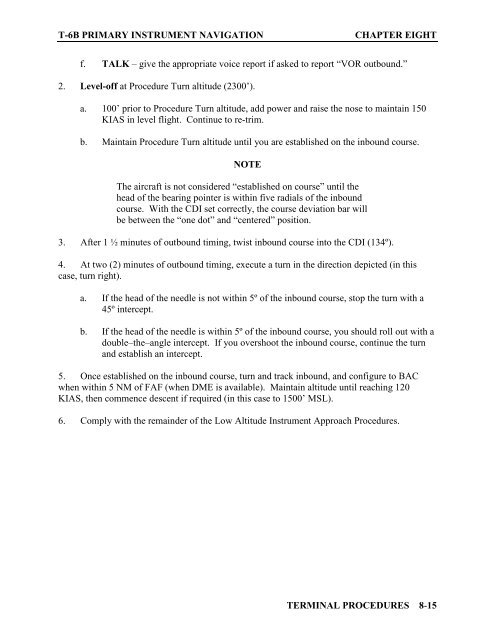Flight Training Instruction - Cnatra - U.S. Navy
Flight Training Instruction - Cnatra - U.S. Navy
Flight Training Instruction - Cnatra - U.S. Navy
Create successful ePaper yourself
Turn your PDF publications into a flip-book with our unique Google optimized e-Paper software.
T-6B PRIMARY INSTRUMENT NAVIGATION CHAPTER EIGHT<br />
f. TALK – give the appropriate voice report if asked to report “VOR outbound.”<br />
2. Level-off at Procedure Turn altitude (2300’).<br />
a. 100’ prior to Procedure Turn altitude, add power and raise the nose to maintain 150<br />
KIAS in level flight. Continue to re-trim.<br />
b. Maintain Procedure Turn altitude until you are established on the inbound course.<br />
NOTE<br />
The aircraft is not considered “established on course” until the<br />
head of the bearing pointer is within five radials of the inbound<br />
course. With the CDI set correctly, the course deviation bar will<br />
be between the “one dot” and “centered” position.<br />
3. After 1 ½ minutes of outbound timing, twist inbound course into the CDI (134º).<br />
4. At two (2) minutes of outbound timing, execute a turn in the direction depicted (in this<br />
case, turn right).<br />
a. If the head of the needle is not within 5º of the inbound course, stop the turn with a<br />
45º intercept.<br />
b. If the head of the needle is within 5º of the inbound course, you should roll out with a<br />
double–the–angle intercept. If you overshoot the inbound course, continue the turn<br />
and establish an intercept.<br />
5. Once established on the inbound course, turn and track inbound, and configure to BAC<br />
when within 5 NM of FAF (when DME is available). Maintain altitude until reaching 120<br />
KIAS, then commence descent if required (in this case to 1500’ MSL).<br />
6. Comply with the remainder of the Low Altitude Instrument Approach Procedures.<br />
TERMINAL PROCEDURES 8-15
















